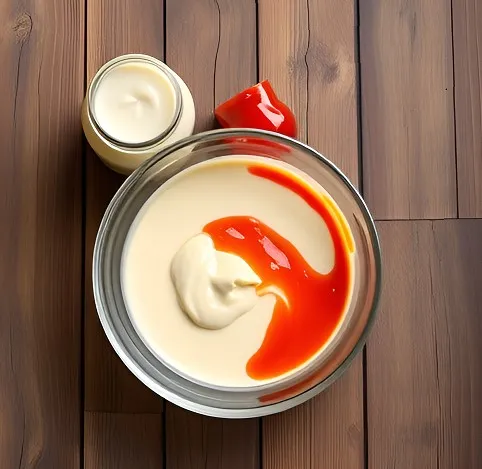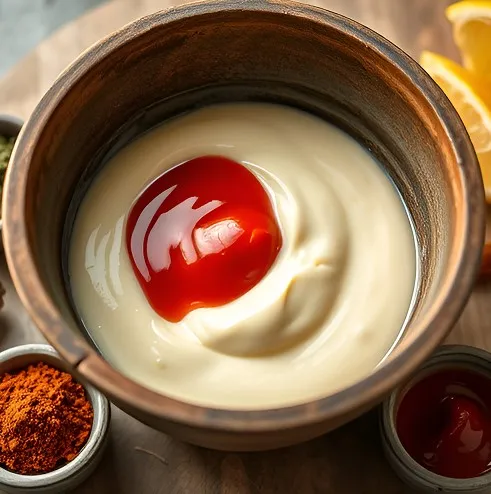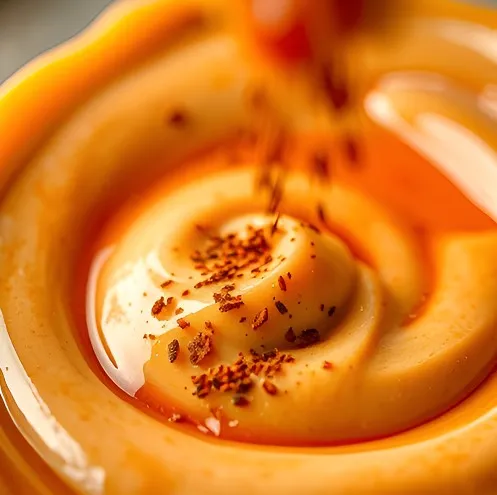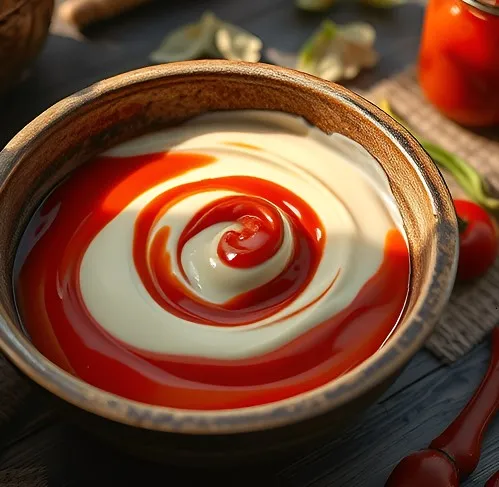Okay, let’s get this show on the road! We’re about to dive deep into the wonderful world of mayo and ketchup sauce. It’s a simple combo, sure, but honestly, it’s a total game-changer. From its humble beginnings to its many names like fry sauce and fancy sauce, we’ll cover everything about this awesome condiment. You might think a mayonnaise and ketchup mix is just a quick thing to do, but trust me, there’s more to it than meets the eye! So, grab your fries, and let’s get started on this tasty journey!
Table of Contents
Mayo and Ketchup sauce : The Perfect Pair
Welcome to a delicious journey through one of the most beloved and underrated condiments out there. If you’ve ever dipped your fries in something creamy yet tangy, or drizzled a secret sauce over your burger, chances are you’ve encountered the magic combination of mayo and ketchup. In this post, we’ll dive deep into everything you need to know about this simple yet endlessly adaptable sauce. From its humble origins to creative twists that can transform an everyday meal into a gourmet experience, get ready to explore why this two-ingredient wonder has earned a permanent spot in kitchens around the world.

The Classic Combination: Understanding Mayo and Ketchup sauce
At its very core, mayo and ketchup sauce is exactly what it sounds like—a blend of mayonnaise and ketchup. This unpretentious mix might seem too simple to warrant much fanfare, but its power lies in its simplicity. You don’t need a shelf full of spices or a hefty list of ingredients to create something that elevates everyday snacks or meals. Instead, this blend takes two kitchen staples and transforms them into a versatile condiment with a flavor profile that’s both creamy and tangy.
The origins of this delightful sauce are as unassuming as it gets. There isn’t a singular “Eureka!” moment documented in culinary history; rather, it evolved gradually as home cooks and fast-food chefs alike experimented with available ingredients. Someone, somewhere discovered that combining the tanginess of ketchup with the smooth richness of mayonnaise produced a flavor balance that simply worked. That spontaneous, almost accidental innovation has now become a mainstay on tables, from casual backyard barbecues to bustling fast-food joints.
The beauty of the mayo and ketchup sauce duo also lies in its universal appeal. It doesn’t matter if you’re enjoying a quick snack or assembling a meal for friends and family—the sauce’s mellow yet distinct taste complements almost any dish. For many, it represents comfort and familiarity, a reminder that sometimes the simplest ideas offer the most satisfaction. Whether you’re a dedicated foodie or someone who only occasionally experiments in the kitchen, the mayo and ketchup blend remains a go-to solution that proves simple can indeed be sublime.
A World of Names: Exploring the Many Monikers
It’s fascinating to see how a simple sauce can carry a variety of nicknames across different regions and cultures. In some circles, this mixture is known as “fancy sauce”—a playful nod to its ability to transform an ordinary dish into something with an air of sophistication. Despite its modest ingredient list, the term “fancy sauce” brings a smile to those who appreciate that a touch of whimsy can make comfort food feel extra special.
Travel a little further, and you might hear the same concoction referred to as “fry sauce.” This variant of nickname is especially popular when it’s served alongside crispy French fries or as a dipping option in diners and fast-food spots across the United States. The name “fry sauce” immediately tells you its best use: providing the perfect complement to salty, crunchy fries. In regions where this term is embraced, slight variations exist in the ratio or even a pinch of extra seasoning, yet the core remains unchanged—a testament to the condiment’s universal allure.
Then there are more straightforward names, such as “pink sauce” or “red sauce,” where the emphasis is on the color transformation the ketchup imparts on the mayonnaise. In these cases, the visual cue of a light pink or rich red blend helps people quickly recognize the flavor profile even before they taste it. From playful to practical, the many names for this sauce all celebrate its simplicity and versatility. They remind us that food has a way of crossing cultural boundaries by connecting us over shared experiences and tastes—even when those experiences come in a vibrant, saucy form.
The Perfect Ratio: Crafting Your Ideal Mayo and Ketchup Sauce
When it comes to creating your ideal mayo and ketchup mixture, starting with a 1:1 ratio is a tried-and-true method. This balanced equal partnership allows the creaminess of the mayonnaise and the tangy sweetness of the ketchup to shine without one overpowering the other. For many, this classic mix conjures up memories of summer picnics, drive-through stops, and inventive homemade meals. However, the beauty of this sauce is its flexibility—it’s not set in stone.
Adjusting the ratio to suit your personal taste can transform the sauce entirely. If you crave a sharper tang and a burst of tomato flavor, simply add a bit more ketchup. On the other hand, if you prefer a richer, velvet-like texture, boosting that mayo will do the trick. The process is as much about personal preference as it is about technique. A quick taste test while mixing can steer you in the right direction; remember, it’s your sauce, so don’t be afraid to improvise until it perfectly matches your palate.
It’s also important to emphasize the role of quality ingredients. A high-quality mayonnaise will deliver a silky texture and a subtle, creamy flavor that elevates the entire mix, while a robust, flavorful ketchup adds depth and brightness. Cheaper versions might work in a pinch, but investing in quality condiments can take your sauce from ordinary to outstanding. Particularly when this blend is the star of a meal—be it slathered on a burger or used as a dip for golden, crispy fries—the difference in ingredient quality can make all the difference in taste.
Another key factor is texture. Achieving a smooth, cohesive blend takes a gentle hand and a bit of patience. Start by lightly whisking the two ingredients together, ensuring that the mixture remains even and free of clumps. Too vigorous stirring could alter the texture, and the goal is a seamless, mouth-pleasing condiment that enhances rather than distracts. Whether you’re crafting the sauce in your home kitchen or whipping it up on the fly at a cookout, that perfect ratio and texture are what define the sauce’s enduring charm.
Adding Flavor to a Simple Base
While the classic mayo and ketchup combo is delightful on its own, there’s a world of possibilities when it comes to taking this basic blend to the next level. One of the easiest ways to upgrade is by incorporating spices and herbs into the mix. A subtle pinch of smoked paprika can add a dash of warmth, while a light dusting of garlic powder introduces a savory note that elevates the flavor profile. For those who enjoy a hint of Mediterranean flair, a pinch of dried oregano can work wonders. These simple additions are perfect for those moments when you crave a more complex taste without complicating the recipe.
Another excellent strategy is to integrate a bit of acidity. A squeeze of fresh lemon or lime juice can brilliantly cut through the creamy richness of the mayo, while a small splash of vinegar adds a tang that brightens the ketchup’s natural sweetness. These acidic touches not only balance the flavors but also introduce a refreshing zing that makes the sauce particularly versatile. Whether you’re using it as a dip or a spread, that extra burst of flavor can transform your dish from ordinary to extraordinary.

For those with a sweet tooth, consider a slight boost from natural sweeteners. A drizzle of honey or a dab of maple syrup can infuse the sauce with a gentle sweetness that plays beautifully against the tang of the ketchup and the creaminess of the mayo. It’s all about finding the right balance. Start with just a little and adjust gradually—remember, you can always add more, but it’s best to avoid overpowering the original flavors.
The beauty of this sauce lies in its ability to act as a blank canvas. This means you have the freedom to experiment with various ingredients based on what you have available or what you’re in the mood for. Some adventurous cooks even toss in a few drops of hot sauce or a spoonful of pickle relish for an unexpected twist. The possibilities are nearly endless, and half the fun is discovering your own signature version that resonates with your taste buds. Experimentation is encouraged; after all, every great condiment begins with a simple idea and a willingness to try something new.
Mayo and Ketchup sauce Around the World: Global Adaptations
One of the most fascinating aspects of the mayo and ketchup sauce is its global appeal. What started as a simple combination in Western kitchens has now taken on new forms as it has traveled across continents. Each region brings its own flavors and cultural twists to the table, resulting in unique adaptations that reflect local culinary traditions. The variation in ingredients and techniques speaks to the universal language of food—simple ingredients, when given a creative twist, can become a beloved staple anywhere.
For instance, in many parts of the United States, the blend is a cherished favorite often dubbed “fry sauce,” especially when served with a side of crispy, perfectly salted fries. Meanwhile, in regions such as Latin America or parts of Europe, local spices or even a dash of regional hot sauce might be mixed in, adding a distinct kick that sets it apart from its more basic counterpart. These regional interpretations show that while the base recipe remains the same, there’s always room for a little cultural flair.
Internationally, the sauce has inspired a myriad of recipes, from gourmet dressings in upscale eateries to a casual drizzle over your everyday burger. Some countries have even elevated the sauce to an art form, considering it a crucial element in recreating traditional street food recipes. The global love for this condiment underscores its adaptability—not only does it provide a familiar taste no matter where you are, but it also adapts beautifully to different palates and dietary needs. This versatility is precisely what keeps it at the forefront of culinary trends around the world.
The variations in flavor profile are also noticeable in the ingredients used. In some cultures, a slightly sweeter version is preferred, using local fruits or special syrups as a substitute or complement to standard ingredients. In others, a bolder, spicier kick is the norm, reflecting a taste for heat. No matter how it’s tweaked, the mayo and ketchup sauce remains a testament to the fact that the simplest ideas often have the widest appeal.
Serving Suggestions: What to Pair with Your Mayo and Ketchup Sauce?
It’s no secret that mayo and ketchup sauce is the ultimate partner in crime when it comes to pairing with a wide range of dishes. Its creamy yet tangy profile makes it an excellent companion for crispy fries—the kind that come out golden and addictive with every bite. The combination of a perfectly balanced dip with salty, crunchy fries is almost universally loved, making it a must-have at fast-food counters and home gatherings alike.

Burgers, sandwiches, and even wraps benefit immensely from a drizzle of this sauce. When added as a spread, it enhances the flavors of the meat, cheese, and fresh produce, tying all the elements together. That secret sauce vibe lends a gourmet twist to even the simplest of sandwiches. Beyond the traditional uses, many find that this versatile blend works wonders with unexpected choices as well. Think about it: onion rings, chicken nuggets, and even crunchy veggie sticks can be elevated with a dip of this magic mix.
For those who enjoy creative plating, there’s plenty of room to experiment. Serving your mayo and ketchup sauce in a small, decorative ramekin can transform its appearance, making it appear as if it belongs on the menu at a trendy bistro. A light dusting of paprika or even a finely chopped herb garnish adds an extra layer of visual appeal and flavor. Presentation, after all, is a key piece of the dining experience. A thoughtfully plated dish not only excites the palate but also pleases the eye, making every bite feel like a treat.
If you’re hosting a dinner party or simply looking to jazz up a family meal, consider incorporating the sauce into a variety of dishes. It can serve as a dipping sauce, a salad dressing component, or even a creative spread on gourmet flatbreads. The beauty of this condiment lies in its adaptability. Its ability to complement such a wide range of dishes makes it a pantry must-have for any home cook who loves both simplicity and innovation in the kitchen.
Health Considerations: Nutritional Information and Smart Consumption
While the blend of mayo and ketchup offers undeniable flavor, it is important to keep health considerations in mind. Mayonnaise, depending on the type and brand, tends to be high in calories and fats, which can add up if used in excess. Ketchup, on the other hand, often contains added sugars, contributing to its sweet profile. Being mindful of the portions you use is key to enjoying this sauce without overindulging.
Fortunately, there are several ways to make adjustments that can lower the calorie and fat content without sacrificing taste. One popular modification is to switch to a lighter version of mayo or substitute some of the mayo with plain Greek yogurt. Some brands also offer ketchup with reduced sugar levels. Ultimately, enjoying this condiment smartly—by keeping portions in check and being conscious of the ingredients—means you can savor its comfort without compromising a balanced diet. Moderation and small tweaks can go a long way, turning a guilty pleasure into a guilt-free delight.
Conclusion
In our fast-paced world, where culinary trends come and go, the simple mayo and ketchup sauce endures as a beacon of comfort and creativity. Its unpretentious nature—merely two classic ingredients—belies the versatility and depth of flavor it brings to countless dishes. Whether you stick with the basic 1:1 ratio or decide to experiment with zesty herbs, a splash of citrus, or even an unexpected twist of spices, every variation is a personal expression of taste.

